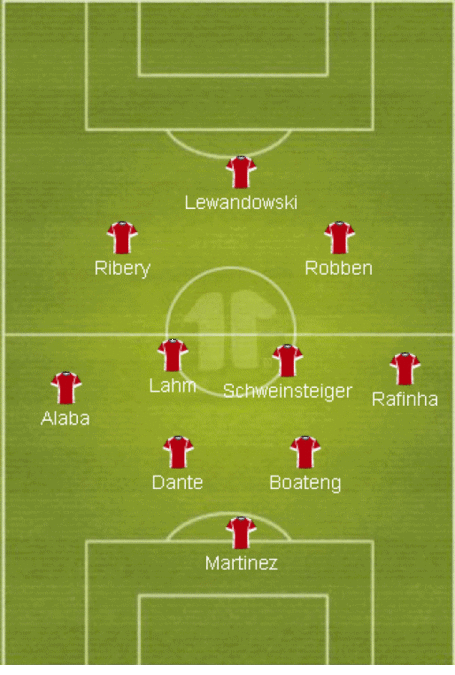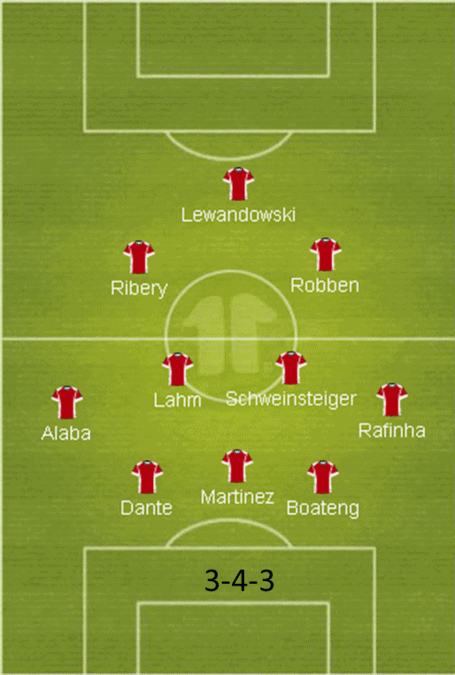/cdn.vox-cdn.com/uploads/chorus_image/image/36500060/452775162.0.jpg)
Last season, Pep Guardiola started out the gate with a 4-1-4-1 system. That systems was built directly around the biggest strengths of Toni Kroos; namely his ability to distribute, shuttle, and playmake up and down the spine of the side. It's exactly this reason that he was considered one of the best central midfielders in European football. It's what lead Real Madrid to buy him for close to €30M just after the World Cup final even though he only had one year left on his contract.
However, in the last 6-9 months we've seen the beginnings of a transition from that 4-1-4-1 to a system using a 3-man backline. Early attempts last winter ranged from unique to downright awful (in the case of the Red Bull Salzburg friendly). Pep Guardiola used a 3-2-2-3 variant both legs against a woeful Manchester United before ultimately rolling out the 3-4-3 against Borussia Dortmund in the DFB Pokal final.
With a full healthy squad the 3-4-3 allows Bayern Munich an almost endless range of versatility and flexibility that, while powerful in it's own right, the 4-1-4-1 didn't allow.
The classical 3-4-3
The classical 3-4-3 archetype has been around for several decades. The formation is extremely strong though the midfield, but like most 3-man backlines, its gains that strength by sacrificing width. The formation naturally struggles against the classical 4-3-3, but with such a possession dominant side like Bayern Munich, the man advantage in midfield can actually be a blessing worth the sacrifice.
While the defensive phase of the game relies on the 3-man backline and the 4-man midfield(including 2 wingbacks), the offensive side of the game has featured several different main archetypes over the years; the 3-4-1-2 and the 3-4-2-1. The former uses an attacking midfielder behind a two striker set. This formation is almost entirely offensive and extremely strong against a 4-man backline, occupying the main centerbacks and opening space for the CAM. The formation was strong in the age of the 4-4-2 with it's numerical supremacy in midfield but dwindled in use as the 4-2-3-1 evolved, eliminating it's chief advantage and attacking it's biggest weakness (lack of width).
The 3-4-2-1 is a much more demanding tactical formation, using two withdrawn strikers/CAMs behind the main striker. It's a formation that requires squads to rotate and be tactically maleable. The two withdrawn strikers are the most critical piece of the attack, for as one shifts wide, the other tucks in behind the main striker to maintain midfield superiority. Without the two strikers up front, much of the supplementary attacking burden in the 3-4-2-1 falls on the wide players: the wingbacks. Without their contributions, the attack can't maintain any numerical superiority in attack and falters more often then not. This requires them to be aggressive yet also disciplined, as they are the only wide defensive options.
The main reason the 3-4-2-1 never become too widespread in use was the demanding nature of the formation. It requires players to be tactically astute. It requires them to have very complete skillsets. And last but far from least, is that it requires players to be at the top of their games physically. The lack of width puts enormous pressure on the wingbacks, while the 3-man press upfront requires a sustained level of coordination. It's good that these are things Bayern Munich has in spades.
Bayern Munich's 3-man backline
The main structural difference between last year's 4-1-4-1 and this year's 3-4-3 is obviously the 3-man backline. Like all 3-man backlines it will have to play narrow and compact in defense. This is something we can basically count on as failure to do this against almost any modern formation is akin to committing suicide.
However, the main focus of the 3-man backline isn't the defensive structure, it's the structure in possession. The main intent is to neuter the opposition press. As we saw in the Pokal final against Borussia Dortmund, offering 3 targets against a two-man press gives Bayern Munich too many passing options. With patience and guile, that press can be exhausted. For sides like Borussia Dortmund or Chelsea that rely on the pressing game as their main defensive strategy, this means they must cede their main defensive advantage against Bayern Munich. When sides opt to be more aggressive by using a three man press, Bayern Munich's ability to drop the wingbacks, along with the presence of two defensive midfielders is already built in to specifically counter that problem.
The key element in the 3-man backline is the central centerback. While both wide centerbacks function like true classical centerbacks, the middle one has to play exactly like a distributing midfielder. This makes it a fantastic position for both Javi Martinez and Holger Badstuber and it also allows them the a certain license in freedom of movement. This is most helpful for Javi Martinez whose best ability is to read opposition attacks, creating interceptions and tackles. If need be the central centerback can step into holding midfield to bring more bodies into the attack or it can drop deeper to act as a libero depending on the offensive setup of the opposition.
Wingbacks and Defensive Midfield Structure are linked entities
In the 2013/2014 DFB Pokal final, the starting formation used Toni Kroos and Phillip Lahm in a double pivot. While Lahm's injury that completely changed the match, the original double pivot did a masterful job of containing the Dortmund press and it's this feature that Pep Guardiola has carried on into the new season.
To date, Guardiola has used a distributor joined with a box-to-box midfielder, often a pairing of Gianluca Gaudino and Sebastian Rode. Now with the return of the rest of the squad expect that partnership to mostly involve Philipp Lahm and Bastian Schweinsteiger. However, where that double pivot becomes really dangerous is when Thiago Alcantara returns from injury. The 24-year-old Spaniard is capable of filling in for Philipp Lahm as the main distributor or he can slot in alongside Philipp Lahm and both players can continuously swap roles presenting the opposition with a shifting movement pattern from holding midfield.
However, in this new system, the lynchpins of the offense become the wingbacks. If they function correctly they allow the entire holding midfield to run like clockwork. If they struggle and get taken out of the match, the whole side can become unbalanced. Guardiola has two options here: he can utilize players like Pierre Hojbjerg and David Alaba, who will tuck centrally, in addition to functioning in attack, allowing the box-to-box midfielder to be much more aggressive. This option plays directly into both Sebastian Rode's wheelhouse, as we've seen this preseason, as well as Bastian Schweinsteiger's (as we've seen for the last 5 years).
The other option is to use players like Juan Bernat and Rafinha who can stay wider and stretch opposition defenses giving more space in the center for the holding midfielders and centerbacks to step into. Either option can be used to target the opposition's main defensive weaknesses. The chief advantage is that switching back and forth between these types of actions is flawless. While a player like Juan Bernat looks to be more suited to hugging the touchline, Rafinha and Alaba are capable of playing in both riles, while Hojbjerg and Rode are more comfortable filling in as secondary defensive midfielders. Adding in the ability of Philipp Lahm to play any of those tactical options, on either side of the pitch, and we being to see just how truly dynamic wingback play could become this season.
The Attacking Trio
With Robert Lewandowski in the fold, Pep Guardiola finally has the dynamic possession-based striker he's always wanted. The mobility Lewandowski brings allows Pep Guardiola to experiment with different attacking midfield skillsets. Lewandowski's can drop deep and play as a false 9 along with his ability to shift out towards the wing and interchange with the wide midfielders, allowing him to bring a high degree of versatility to the Bayern Munich attack. Partnering with Franck Ribery and Arjen Robben who have been given a more free role in Pep Guardiola's team, gives Bayern Munich the potential for a highly dynamic and explosive attacking midfield. Adding in Thomas Müller and Mario Götze gives Bayern Munich more disciplined and creative options capable of adding tactical nuances. But more important then both of those players are the roles Xherdan Shaqiri and Thiago Alcantara could play. With a simple change, or even no change, Bayern Munich can easily shift into a 3-4-1-2. Both Shaqiri and Thiago's ability to dribble, create, and play off a main striker anywhere along the attacking band would give them the freedom to completely take over a match offensively feeding a potent striker partnership hammering away at the opposition
Tactical Flexibility
As we saw last year with the 4-1-4-1, the main key to Pep Guardiola's managerial style at Bayern Munich is tactical flexibility. Without altering personnel this formation can be shifted into a 4-2-3-1 or a 4-3-3, a 3-5-2, or even the 3-2-2-3 as the roles between the three different formation prove to be extremely complementary. Whichever way Pep Guardiola ends up rolling, this season is going to be extremely interesting tactically and the 3-4-2-1 is at the heart of that.


